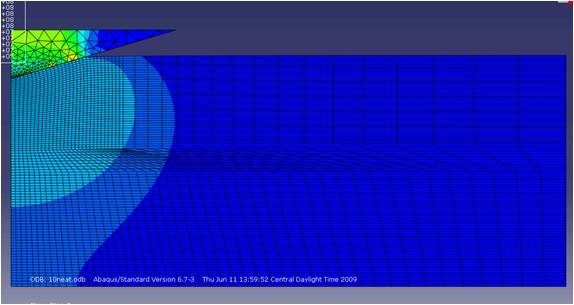Coupled nanoindentation experiments and modeling of polymer nanocomposites and thin model nanocomposite films
Addition of nanoparticles to a polymer matrix has been found to improve thermal and mechanical properties of the nanocomposite materials such as glass transition temperature (Tg), physical aging, storage and loss moduli, strength, and toughness. Polymer-particle interfaces play a major role in such findings. Polymer surrounding each nanoparticle has altered properties due to the reduced mobility of the polymer chains at these interfaces, leading to a zone of altered properties called the interphase. In these systems with high particle surface area, the interphase zones can percolate through material leading to dramatic changes in bulk properties. Therefore, it is crucial to understand the impact of interfaces on the local (nanoscale) properties.
While the thermal properties - Tg and physical aging - of polymers confined in thin films have been widely studied over the past 15 years, the local mechanical properties are poorly understood. Challenges in probing confined polymer in such small scale dimensions make it difficult to successfully measure the mechanical properties locally and directly. Here, we introduce a new direct approach using nanoindentation experiments coupled with modeling. In this method, the thermomechanical properties of thin polymer films can be measured as a function of distance from a polymer-substrate interface.

Direct mechanical measurement of thin polymer films is commonly complicated by the presence of the substrate making it impossible to obtain the mechanical properties of the polymer directly. Moreover, the properties measured in this technique are combined properties of not only the neat polymer but coupled with the interphase regime of altered polymer extending from the substrate. To resolve the local mechanical properties of thin polymer films as a function of distance from an interface, our new approach is outlined in Figure 1. Coupling experiments with modeling, we are working to extract the true properties of the interphase - the gradient from surface to bulk response - from the effects of substrates and nanoparticles. After experimental results are obtained, an iterative modeling approach can be taken, where the properties of the interphase gradient are modified to match the experimental results.
Nanoindentation experiments

Force-controlled indentation tests are performed through Hysitron TriboIndenter. Real time data of force and displacement are collected. Figure 2 shows the force-displacement curves from nanoindentation testing on PMMA. The indent impressions made with a trapezoidal force profile (upper right inset) are left on the polymer surface as shown in an AFM scan (upper left inset). Elastic modulus is determined from measured quantities such as maximum load and displacement and contact stiffness defined as the slope of initial unloading curve.
The nanoindenter is also equipped with a temperature stage, feedback control and nanoDMA, which allows for broad suite of nanomechanical testings. In addition to elastic modulus obtained from the quasi-static nanoindentation, creep compliance, relaxation modulus, glass transition and storage and loss moduli can be also measured.
Modeling of nanoindentation

When coupled with experiments, finite element modeling of nanoindentation can be used to decouple substrate effects from indentation data on thin films. These models examine varying ratios of interphase thickness to total thickness for increasing contact depths. Once the substrate effect is removed, these models can then be implemented to find elastic and viscoelastic properties of the bulk material as well as the interphase due to substrate interactions or surrounding nano-fillers such as titania or carbon nanofibers. In the latter case, the nanoparticles can either be coated on the substrate or included as an embedded layer in the thin film. Results from simulations are compared to experimental data to ultimately determine properties of the interphase: such as thickness, modulus, and gradient. Additional modeling of dynamic testing (nanoDMA) with frequency response allows for capability to capture viscoelastic properties of the interphase, such as storage and loss modulii, when coupled in the same manner with experimental values.